Investigation of Structural and Tribological Characteristics of TiN Composite Ceramic Coatings with Pb Additives
Abstract
:1. Introduction
2. Materials and Methods
3. Results
3.1. Surface Structure and Elemental Composition
3.2. Surface Roughness
3.3. Cross-Section Coatings Structure
3.4. Phase Composition
3.5. Microhardness
3.6. Tribological Tests at Room Temperature
3.7. Tribological Tests under Stepwise Heating Conditions
3.8. XRD Analysis after Stepwise Heating
3.9. Tribological Study of a Nanostructured Composite Coating at Various Loading Parameters
4. Discussion
5. Conclusions
Author Contributions
Funding
Institutional Review Board Statement
Informed Consent Statement
Data Availability Statement
Conflicts of Interest
References
- Aouadi, S.M.; Luster, B.; Kohli, P.; Muratore, C.; Voevodin, A.A. Progress in the development of adaptive nitride-based coatings for high temperature tribological applications. Surf. Coat. Technol. 2009, 204, 962–968. [Google Scholar] [CrossRef]
- Aouadi, S.M.; Gao, H.; Martini, A.; Scharf, T.W.; Muratore, C. Lubricious oxide coatings for extreme temperature applications: A review. Surf. Coat. Technol. 2014, 257, 266–277. [Google Scholar] [CrossRef]
- Lesnevskii, L.N.; Lezhnev, L.Y.; Lyakhovetskii, M.A.; Troshin, A.E.; Ushakov, A.M. Wear resistance of composite plasma coatings with graphite. J. Mach. Manufact. Reliabil. 2017, 46, 25–32. [Google Scholar] [CrossRef]
- Ouyang, J.-H.; Li, Y.-F.; Zhang, Y.-Z.; Wang, Y.-M.; Wang, Y.-J. High-Temperature Solid Lubricants and Self-Lubricating Composites: A Critical Review. Lubricants 2022, 10, 177. [Google Scholar] [CrossRef]
- Lenz, B.; Hoja, S.; Sommer, M.; Hasselbruch, H.; Mehner, A.; Steinbacher, M. Potential of Nitrided and PVD-MoS2:Ti-Coated Duplex System for Dry-Running Friction Contacts. Lubricants 2022, 10, 229. [Google Scholar] [CrossRef]
- Von Fieandt, K.; Paschalidou, E.-M.; Srinath, A.; Soucek, P.; Riekehr, L.; Nyholm, L.; Lewin, E. Multi-component (Al, Cr, Nb, Y, Zr) N thin films by reactive magnetron sputter deposition for increased hardness and corrosion resistance. Thin Solid Films 2020, 693, 137685. [Google Scholar] [CrossRef]
- Betsofen, S.Y.; Plikunov, V.V.; Petrov, L.M.; Bannykh, I.O. Study of the phase composition and structure of multicomponent vacuum ion-plasma coatings (Ti, Nb, Me) N and (Zr, Nb) N (C), depending on their chemical composition and technology parameters. Aviat. Ind. 2007, 4, 9–15. [Google Scholar]
- Bogdanski, M.S.; Sliney, H.E.; Della Corte, C. The effect of processing and compositional changes on the tribology of PM212 in air. Lubric. Eng. 1992, 48, 675–683. [Google Scholar]
- Zabinski, J.S.; Sanders, J.H.; Nainaparampil, J.; Prasad, S.V. Lubrication using a microstructurally engineered oxide: Performance and mechanisms. Tribol. Lett. 2000, 8, 103–116. [Google Scholar] [CrossRef]
- Muratore, C.; Voevodin, A.A. Chameleon coatings: Adaptive surfaces to reduce friction and wear in extreme environments. Annu. Rev. Mater. Res. 2009, 39, 297–324. [Google Scholar] [CrossRef]
- Hasegava, H.; Kimura, A.; Suzuki, T. Ti1−xAlxN, Ti1−xZrxN and Ti1−xCrxN films synthesized by the AIP method. Surf. Coat. Technol. 2000, 132, 76–79. [Google Scholar] [CrossRef]
- Yoo, Y.H.; Le, D.P.; Kim, J.G.; Kim, S.K.; Vinh, P.V. Corrosion behavior of TiN, TiAlN, TiAlSiN thin films deposited on tool steel in the 3.5 wt.% NaCl solution. Thin Solid Films 2008, 516, 3544–3548. [Google Scholar] [CrossRef]
- Lewis, D.B.; Donohue, L.A. The influence of the yttrium content on structure and properties of Ti1−x−y−zAlxCryYzN PVD hard coatings. Surf. Coat. Technol. 1999, 114, 187–199. [Google Scholar] [CrossRef]
- Kong, Q.; Li, J.; Li, H.; Liu, X.; Wang, Y.; Chen, J.; Zhou, H. Composition, microstructure, and properties of CrNx films deposited using medium frequency magnetron sputtering. Appl. Surf. Sci. 2011, 257, 2269–2274. [Google Scholar] [CrossRef]
- Shuyong, T.; Zhang, X.; Wu, X.; Fang, F.; Jiang, J. Effect of substrate bias and temperature on magnetron sputtered CrSiN films. Appl. Surf. Sci. 2011, 257, 1850–1853. [Google Scholar]
- Chang, C.-L.; Lin, C.-T.; Tsai, P.-C.; Ho, W.-Y.; Wang, D.-Y. Influence of bias voltages on the structure and wear properties of TiSiN coating synthesized by cathodic arc plasma evaporation. Thin Solid Films 2008, 516, 5324–5329. [Google Scholar] [CrossRef]
- Discerens, M.; Patscheider, J.; Levy, F. Improving the properties of titanium nitride by incorporation of silicon. Surf. Coat. Technol. 1998, 108–109, 241–246. [Google Scholar] [CrossRef]
- Mei, H.; Wang, R.; Zhong, X.; Wei, D.; Wang, Q. Influence of Nitrogen Partial Pressure on Microstructure and Tribological Properties of Mo-Cu-V-N Composite Coatings with High Cu Content. Coatings 2018, 8, 24. [Google Scholar] [CrossRef]
- Ashmarin, A.A.; Betsofen, S.Y.; Petrov, L.M.; Lebedev, M.A. Effect of bias voltage on the texture of the TiN and ZrN coatings deposited by vacuum ion-plasma method. Mat. Sci. Eng. 2020, 889, 012019. [Google Scholar] [CrossRef]
- Najafia, H.; Karimia, A.; Dessarzinb, P.; Morsteinb, M. Correlation between anionic substitution and structural properties in AlCr(OxN1−x) coatings deposited by lateral rotating cathode arc PVD. Thin Solid Films 2011, 520, 1597–1602. [Google Scholar] [CrossRef]
- Gardos, M.N. Magnéli phases of anion-deficient rutile as lubricious oxides. Part I. Tribological behavior of single-crystal and polycrystalline rutile (TinO2n−1). Tribol. Lett. 2000, 8, 65–78. [Google Scholar] [CrossRef]
- Mulligan, C.P.; Gall, D. CrN-Ag self-lubricating hard coatings. Surf. Coat. Technol. 2005, 200, 1495–1500. [Google Scholar] [CrossRef]
- Kutschej, K.; Mitterer, C.; Mulligan, C.P.; Gall, D. High-temperature tribological behavior of CrN-Ag self-lubricating coatings. Ad. Eng. Mat. 2006, 8, 1125–1129. [Google Scholar] [CrossRef]
- Stone, D.S.; Migas, J.; Martini, A.; Smith, T.; Muratore, C.; Voevodin, A.A.; Aouadi, S.M. Adaptive NbN/Ag coatings for high temperature tribological applications. Surf. Coat. Technol. 2012, 206, 4316–4321. [Google Scholar] [CrossRef]
- Bondarev, A.V.; Kvashnin, D.G.; Shchetinin, I.V.; Shtansky, D.V. Temperature-dependent structural transformation and friction behavior of nanocomposite VCN-(Ag) coatings. Mater. Des. 2018, 160, 964–973. [Google Scholar] [CrossRef]
- Bondarev, A.V.; Kiryukhantsev-Korneev, P.V.; Levashov, E.A.; Shtansky, D.V. Tribological behavior and self-healing functionality of TiNbCN-Ag coatings in wide temperature range. Appl. Surf. Sci. 2017, 396, 110–120. [Google Scholar] [CrossRef]
- Zabinski, J.S.; Donley, M.S.; Dyhouse, V.J.; McDevitt, N.T. Chemical and tribological characterization of PbO-MoS2 films grown by pulsed laser deposition. Thin Solid Films 1992, 214, 156–163. [Google Scholar] [CrossRef]
- Zabinski, J.S.; Day, A.E.; Donley, M.S.; Dellacorte, C.; McDevitt, N.T. Synthesis and characterization of a high-temperature oxide lubricant. J. Mat. Sci. 1994, 29, 5875–5879. [Google Scholar] [CrossRef]
- Peng, C.; Zhao, Y.; Jin, S.; Wang, J.; Liu, R.; Liu, H.; Shi, W.; Kolawole, S.K.; Ren, L.; Yu, B.; et al. Antibacterial TiCu/TiCuN Multilayer Films with Good Corrosion Resistance Deposited by Axial Magnetic Field-Enhanced Arc Ion Plating. ACS Appl. Mater. Interfaces 2019, 11, 125–136. [Google Scholar] [CrossRef]
- Wei, C.B.; Tian, X.B.; Yang, Y.; Yang, S.Q.; Fu, K.Y.; Chu, P.K. Microstructure and tribological properties of Cu–Zn/TiN multilayers fabricated by dual magnetron sputtering. Surf. Coat. Technol. 2007, 202, 189–193. [Google Scholar] [CrossRef]
- Mukhopadhyay, A.K.; Roy, A.; Bhattacharjee, G.; Das, S.C.; Majumdar, A.; Wulff, H.; Hippler, R. Surface Stoichiometry and Depth Profile of Tix-CuyNz Thin Films Deposited by Magnetron Sputtering. Materials 2021, 14, 3191. [Google Scholar] [CrossRef]
- Myunga, H.S.; Lee, H.M.; Shaginyan, L.R.; Han, J.G. Microstructure and mechanical properties of Cu doped TiN superhard nanocomposite coatings. Surf. Coat. Technol. 2003, 163–164, 591–596. [Google Scholar] [CrossRef]
- Zhu, Y.D.; Yan, M.F.; Zhang, Y.X.; Chen, H.T.; Yang, Y. Microstructure formation and evolution mechanism of Cu-Ti coating during dual-magnetron sputtering and thermo plasma nitriding. Vacuum 2016, 134, 25–28. [Google Scholar] [CrossRef]
- Voevodin, A.A.; Muratore, C.; Aouadi, S.M. Hard coatings with high temperature adaptive lubrication and contact thermal management: Review. Surf. Coat. Technol. 2014, 257, 247–265. [Google Scholar] [CrossRef]
- Lozovan, A.A.; Betsofen, S.Y.; Savushkina, S.V.; Lychovetsky, M.A.; Lesnevsky, L.N.; Nikolaev, I.A.; Kubatina, E.P. Influence of Sputtering Geometry and Conditions on the Structure and Properties of the TiN–Pb Solid Lubricating Coatings Fabricated by Magnetron Co-Sputtering of Two Separate Targets. Russ. Metall. 2022, 11, 1441–1448. [Google Scholar] [CrossRef]
- Lozovan, A.A.; Lesnevsky, L.N.; Betsofen, S.Y.; Liakhovetsky, M.A.; Ushakov, A.M. Structure and properties of solid lubricating coatings based on the TiN-Pb system. IOP Conf. Ser. Mat. Sci. Eng. 2018, 387, 01204. [Google Scholar] [CrossRef]
- Guleryuz, C.G.; Krzanowski, J.E.; Veldhuis, S.C.; Fox-Rabinovich, G.S. Machining performance of TiN coatings incorporating indium as a solid lubricant as placeholders for microreservoir formation. Surf. Coat. Technol. 2009, 203, 3370–3376. [Google Scholar] [CrossRef]
- Thorton, J.A.; Hoffman, D.W. Stress—Related effects in thin films. Thin Solid Films 1989, 171, 5–31. [Google Scholar] [CrossRef]
- Su, J.F.; Nie, X.; Hu, H. Friction and counterface wear influenced by surface profiles of plasma electrolytic oxidation coatings on an aluminum A356 alloy. J. Vac. Sci. Technol. A 2012, 30, 061402. [Google Scholar]
- Yea, F.; Sun, X. Nanoindentation response analysis of TiN-Cu coating deposited by magnetron sputtering. Prog. Nat. Sci. Mat. Int. 2018, 28, 40–44. [Google Scholar] [CrossRef]
- Lozovan, A.A.; Betsofen, S.Y.; Lyakhovetskiy, M.A.; Pavlov, Y.S.; Grushin, I.A.; Kubatina, E.P.; Nikolaev, I.A. Structure and properties of TiN–Pb composite coatings deposited on VT6 alloy by DC magnetron sputtering. Russ. J. Non-Ferr. Met. 2021, 4, 70–77. (In Russian) [Google Scholar] [CrossRef]
- Saal, J.E.; Kirklin, S.; Aykol, M.; Meredig, B.; Wolverton, C. Materials Design and Discovery with High-Throughput Density Functional Theory: The Open Quantum Materials Database (OQMD). JOM 2013, 65, 1501–1509. [Google Scholar] [CrossRef]
- Suciu, C.V.; Uchida, T. Modeling and Simulation of the Fretting Hysteresis Loop. Parallel, Grid, Cloud and Internet Computing. In Proceedings of the 3PGCIC 2010, International Conference on P2P, Fukuoka Institute of Technology, Fukuoka, Japan, 4–6 November 2010; p. 560. [Google Scholar]
- Lesnevskiy, L.N.; Lyakhovetskiy, M.A.; Savushkina, S.V. Fretting wear of composite ceramic coating produced on D16 aluminum-based alloy using microarc oxidation. J. Frict. Wear. 2016, 37, 268–273. [Google Scholar] [CrossRef]
- Subramanian, B.; Muraleedharan, C.V.; Ananthakumar, R.; Jayachandran, M. A comparative study of titanium nitride (TiN), titanium oxy nitride (TiON) and titanium aluminum nitride (TiAlN), as surface coatings for bio implants. Surf. Coat. Technol. 2011, 205, 5014–5020. [Google Scholar] [CrossRef]
- Fouvry, S.; Kapsa, P.; Vincent, L. Quantification of fretting damage. Wear 1996, 200, 186–205. [Google Scholar] [CrossRef]
- Dervaux, J.; Cormier, P.-A.; Moskovkin, P.; Douheret, O.; Konstantinidis, S.; Lazzaroni, R.; Lucas, S.; Snyders, R. Synthesis of nanostructured Ti thin films by combining glancing angle deposition and magnetron sputtering: A joint experimental and modeling study. Thin Solid Films 2017, 636, 644–657. [Google Scholar] [CrossRef]
- Robbie, K.; Brett, M.J. Sculptured thin films and glancing angle deposition: Growth mechanics and applications. J. Vac. Sci. Technol. 1997, 15, 1460–1465. [Google Scholar] [CrossRef]
- Stempfle, P.; Besnard, A.; Martin, N.; Domatti, A.; Takadoum, J. Accurate control of friction with nanosculptured thin coatings: Application to gripping in microscale assembly. Tribol. Int. 2013, 59, 67–78. [Google Scholar] [CrossRef]
- Jimenez, M.J.M.; Antunes, V.G.; Zagonel, L.F.; Figueroa, C.A.; Wisnivesky, D.; Alvarez, F. Effect of the period of the substrate oscillation in the dynamic glancing angle deposition technique: A columnar periodic nanostructure formation. Surf. Coat. Technol. 2020, 383, 125237. [Google Scholar] [CrossRef]
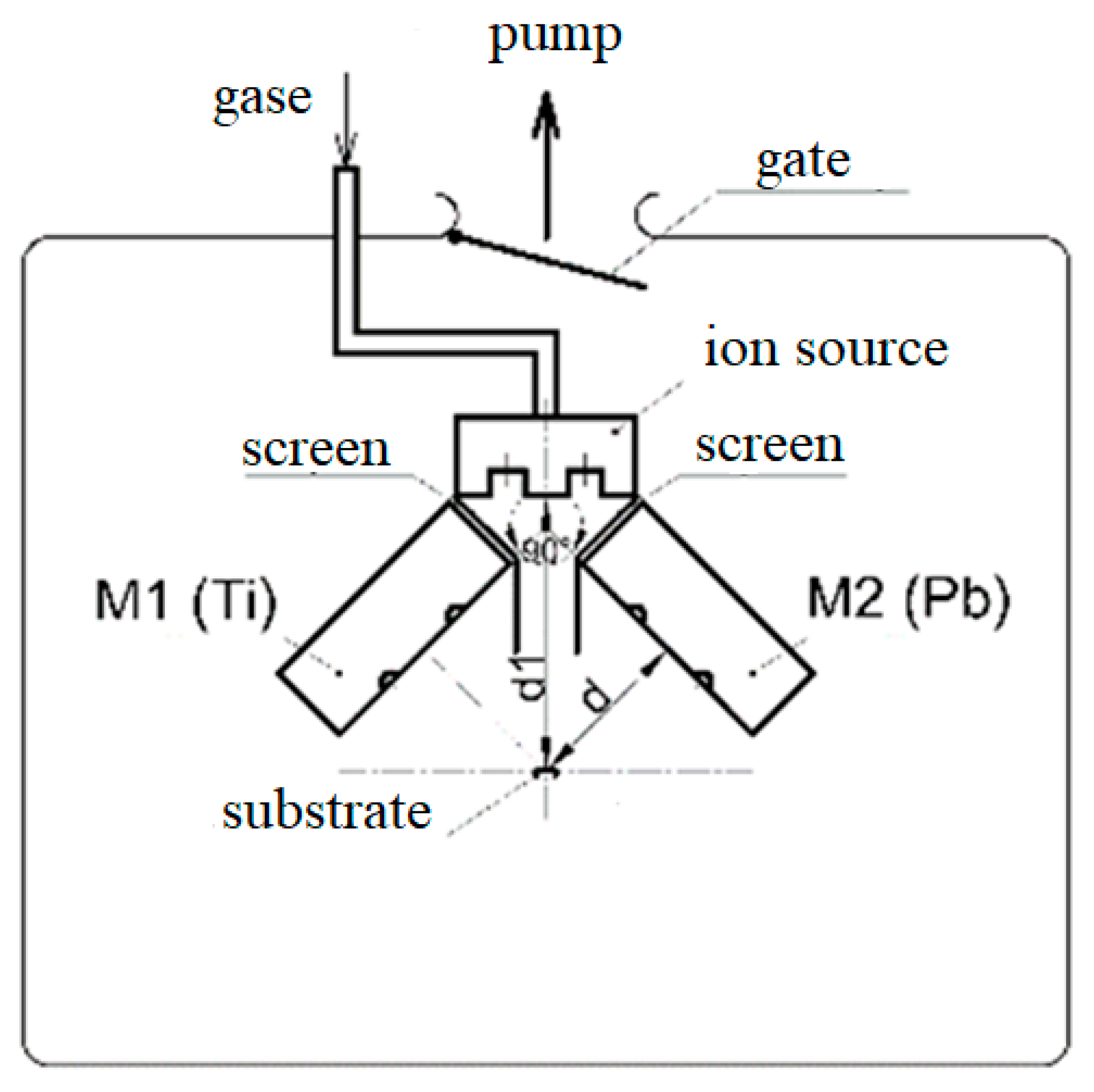

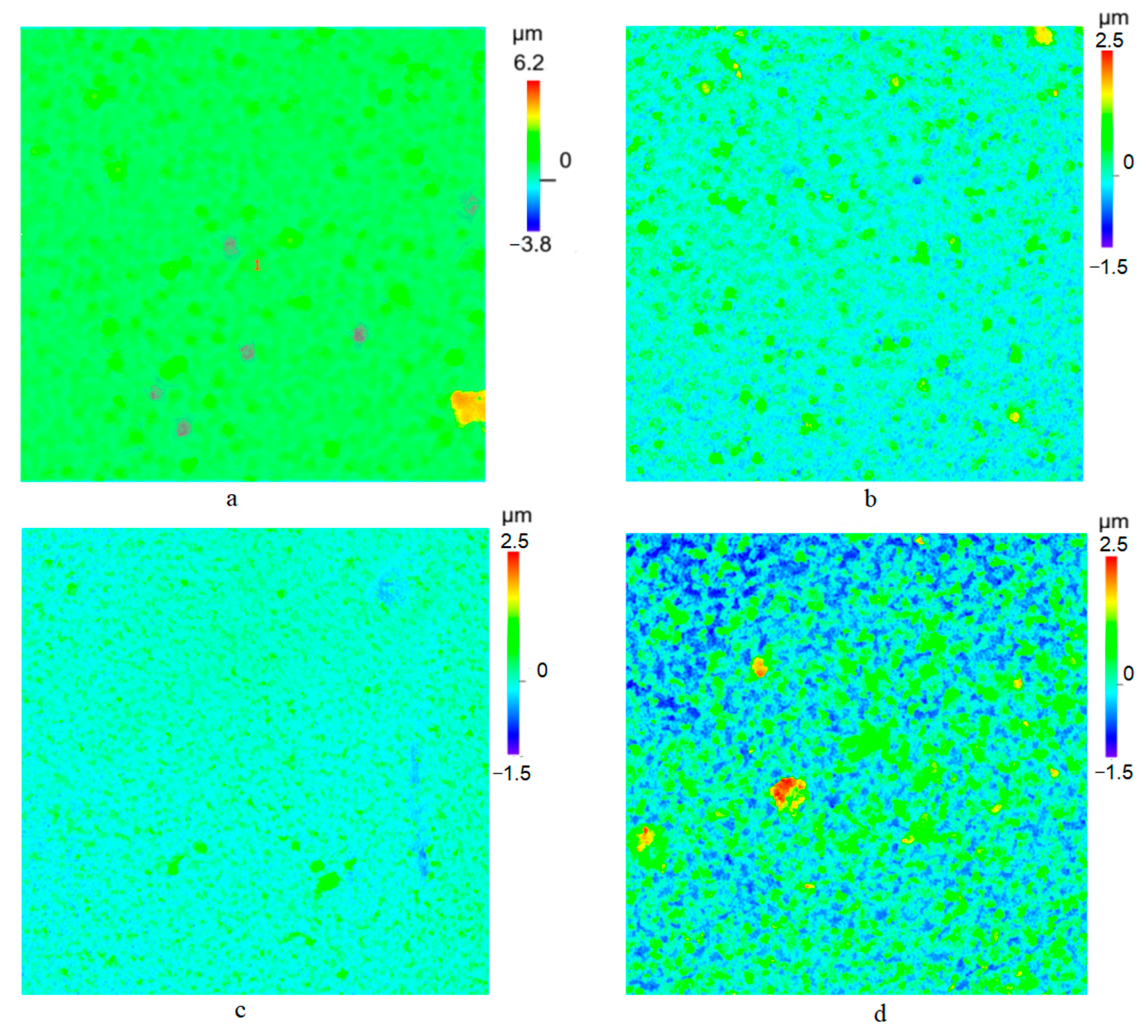

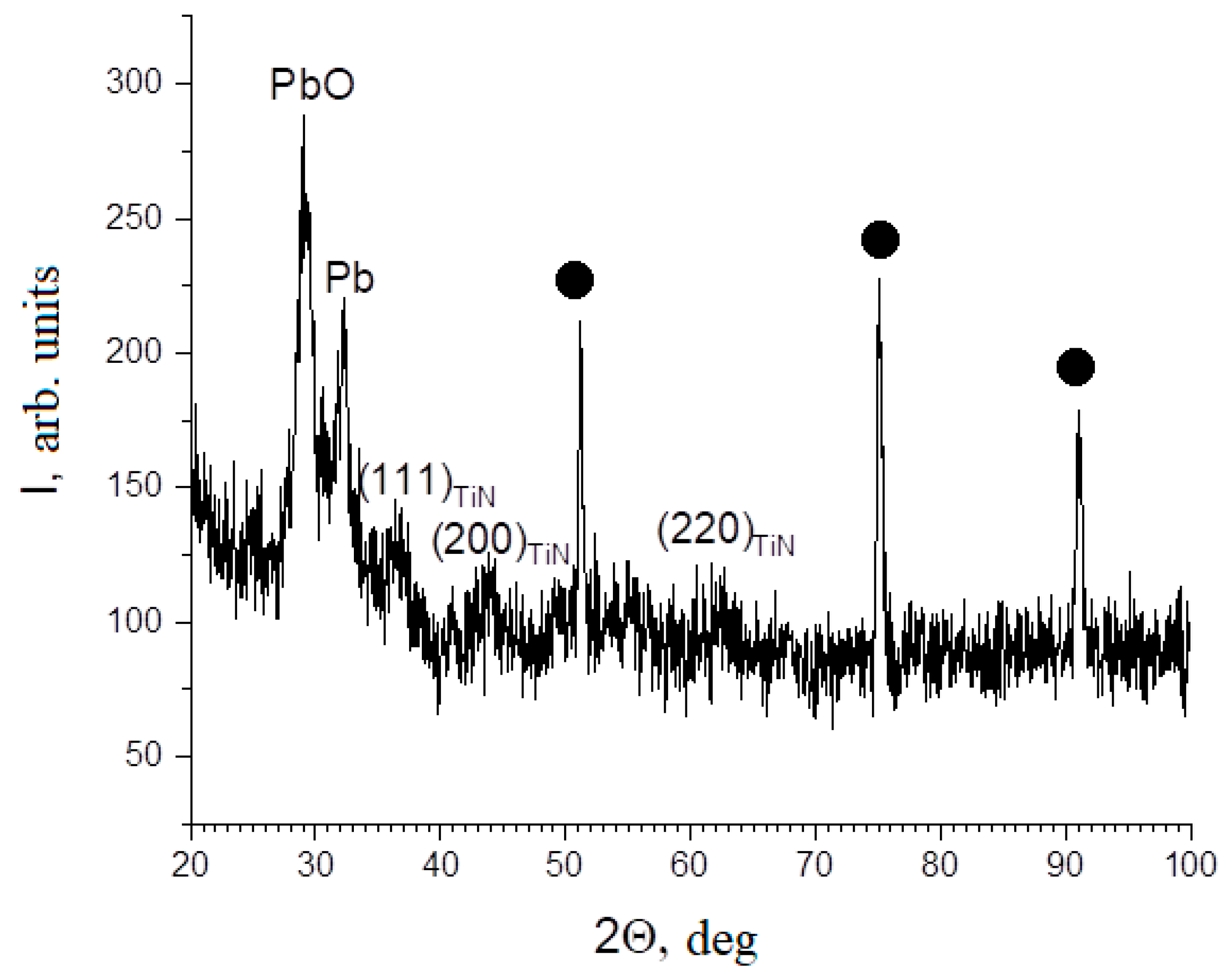
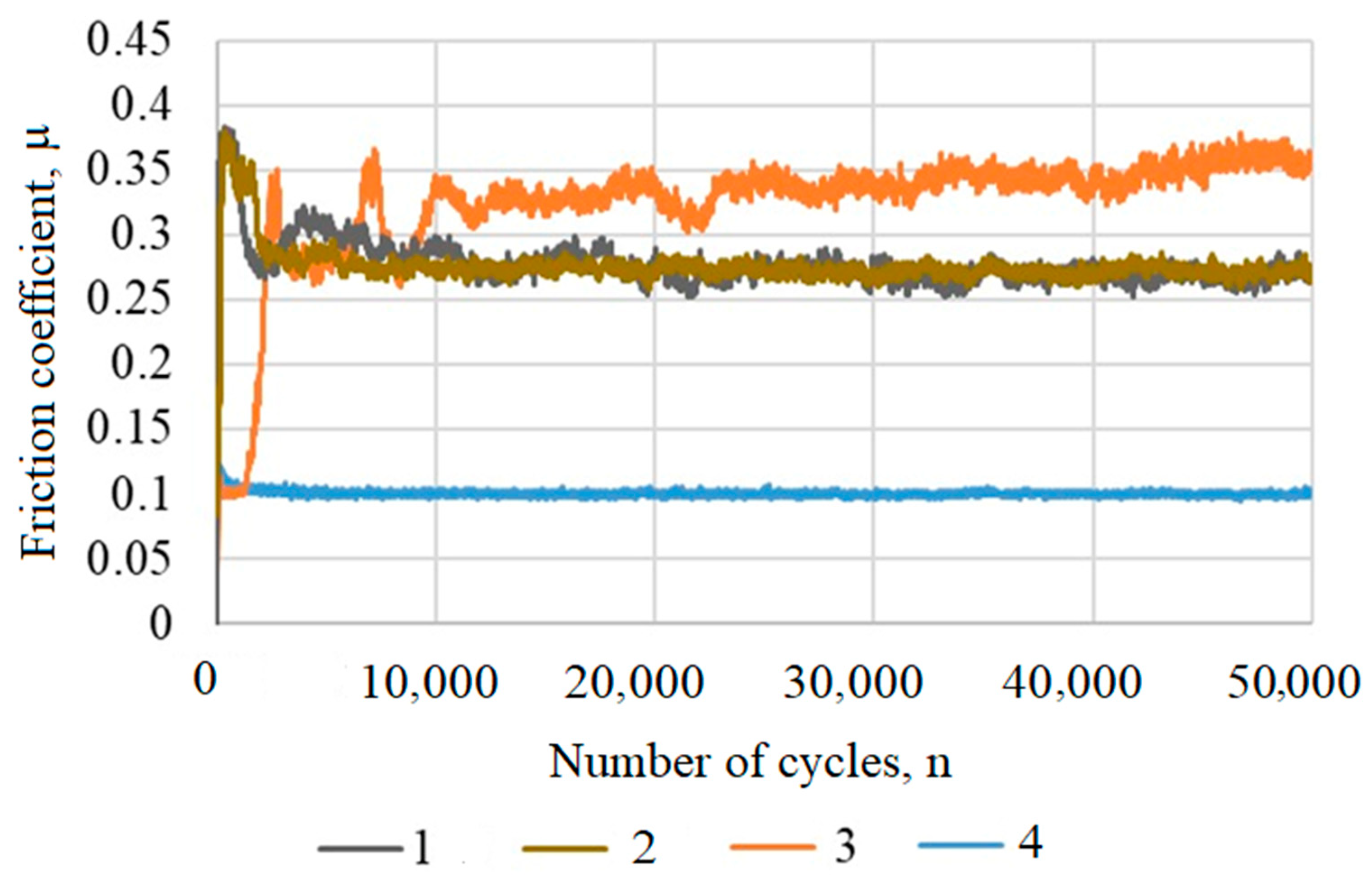
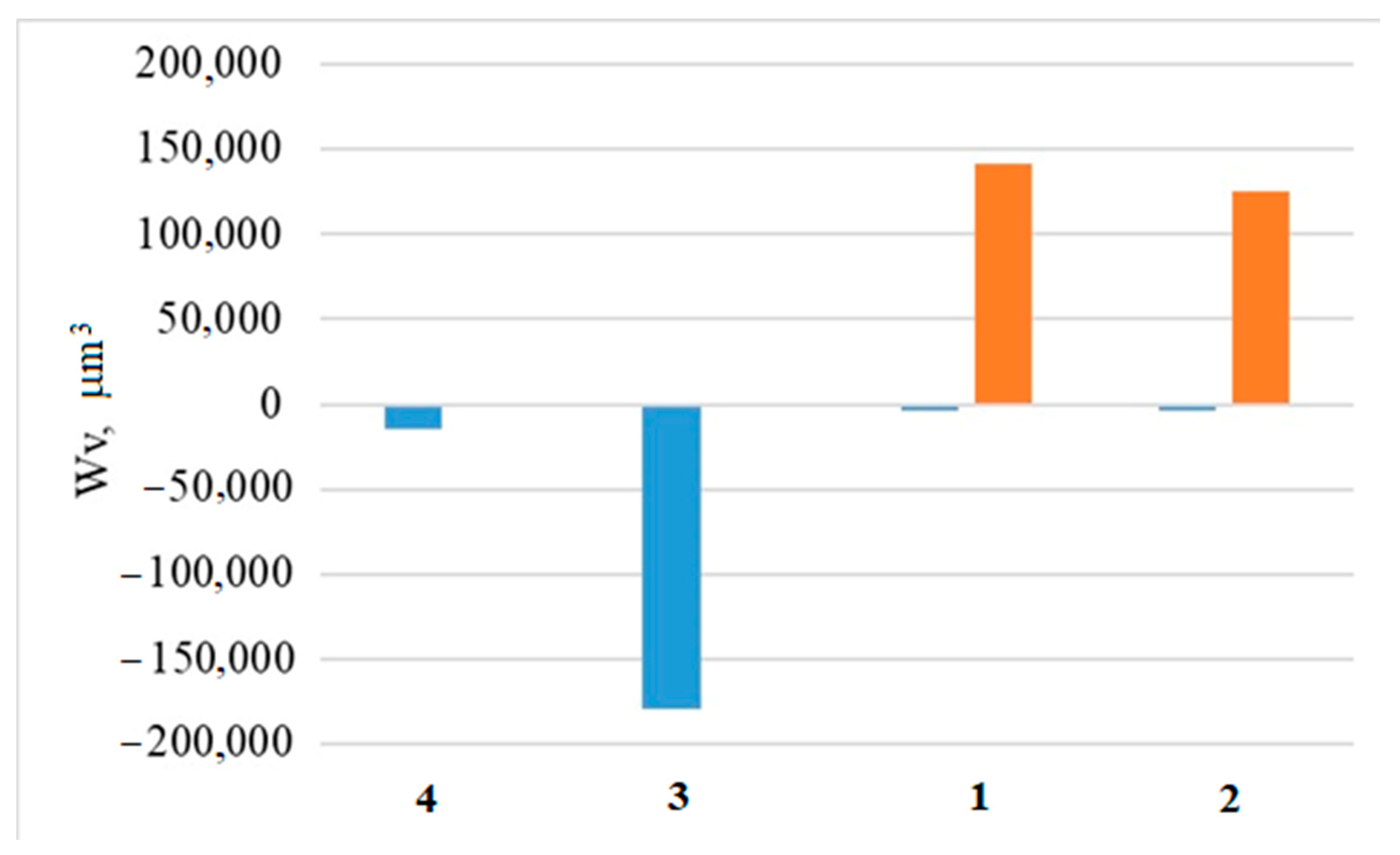
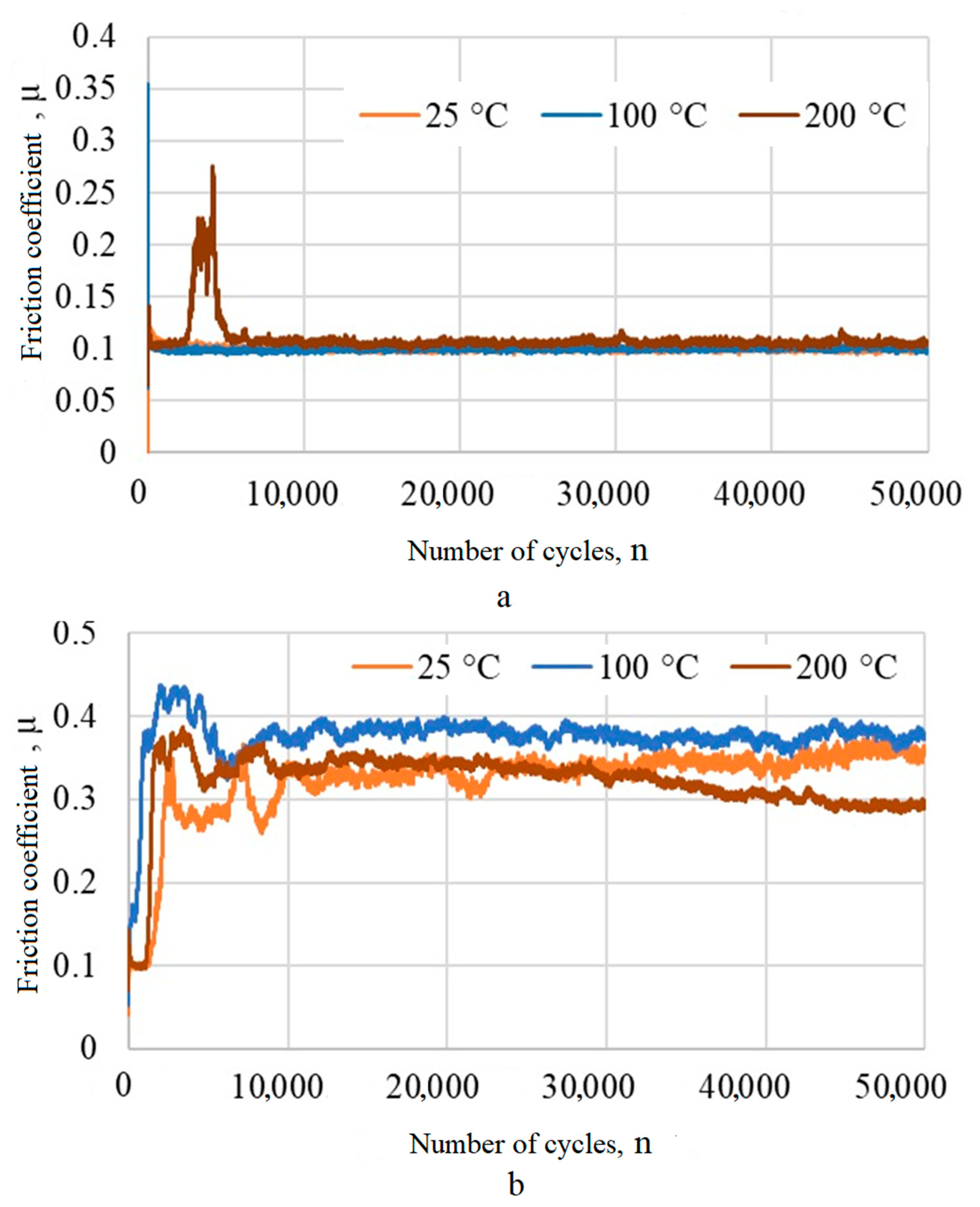

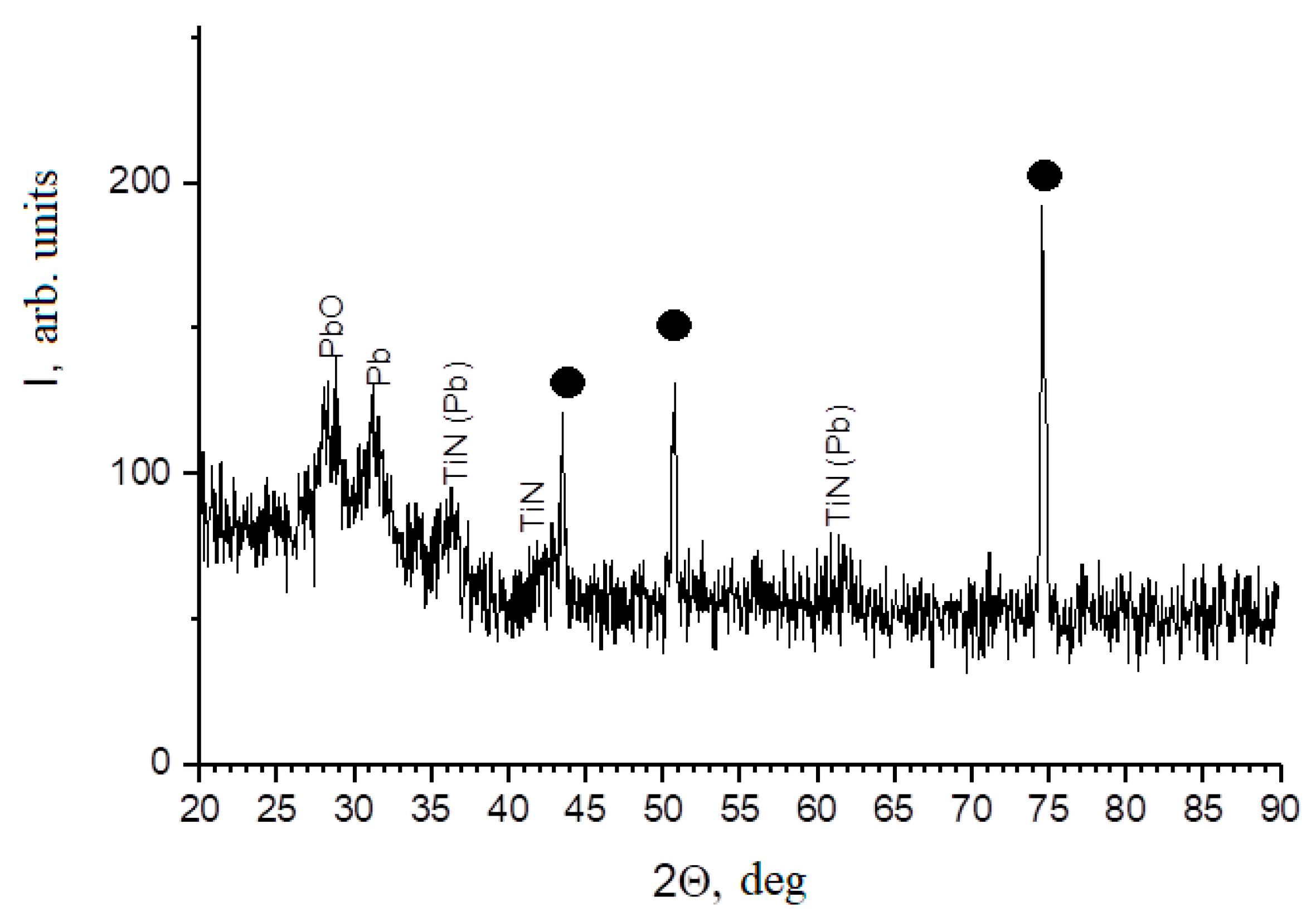

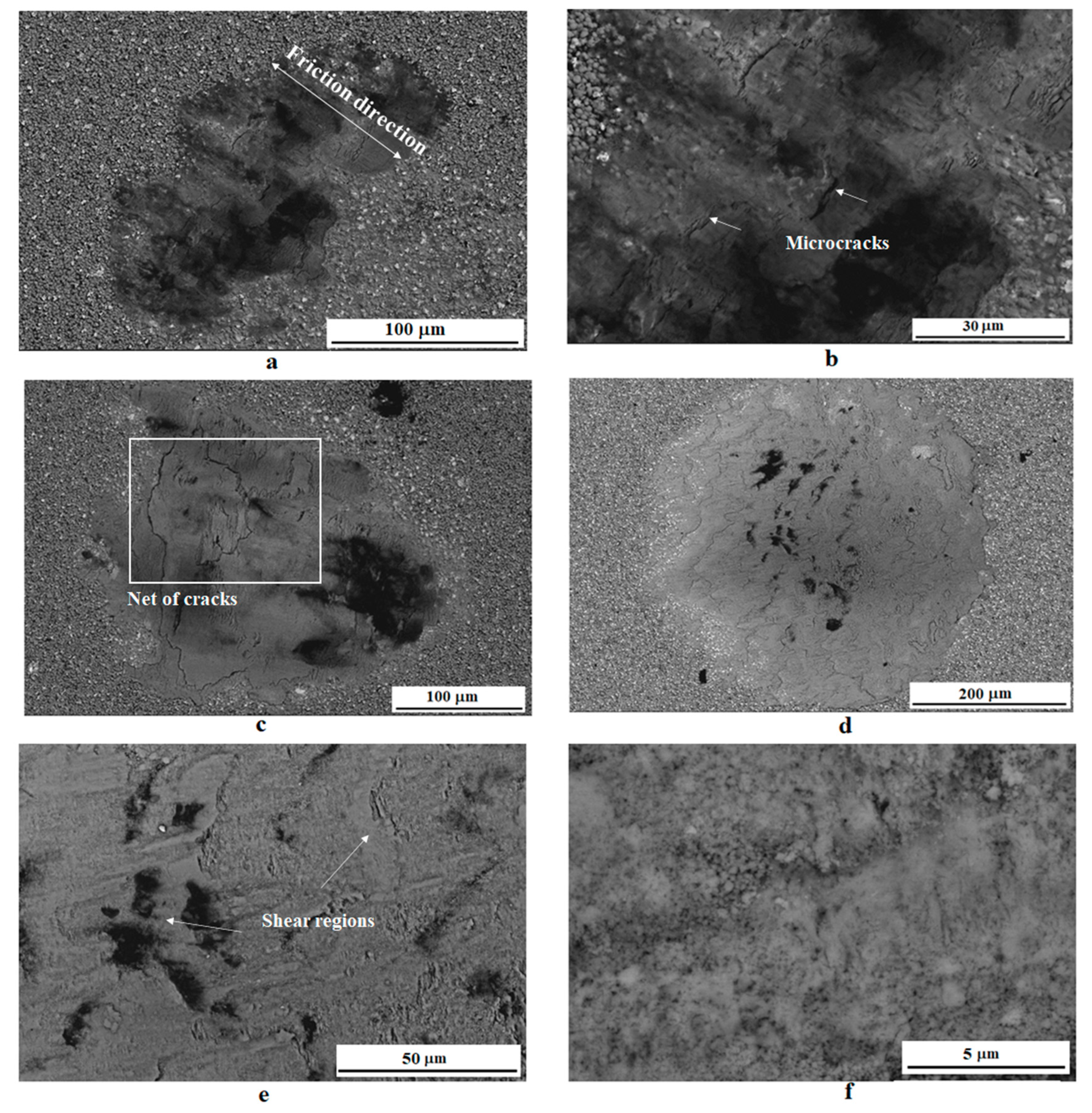

| No. | Substrate | PAr+N2, Pa | QAr, cm3/min | QN2, cm3/min | ITi, A | IPb, A | t, min | F, kHz | d, mm | d1, mm | n, rpm |
|---|---|---|---|---|---|---|---|---|---|---|---|
| 1 | steel | 0.31 | 8.65 | 2.45 | 3.5 | 0.1 | 720 | - | 100 | 160 | 2 |
| 2 | steel | 0.25 | 8.54 | 4.1 | 3.5 | 0.1 | 350 | - | 100 | 160 | 2 |
| 3 | steel | 0.24 | 6.52 | 5.14 | 3.5 | 0.1 | 350 | 25 | 220 | 250 | - |
| 4 | steel, Ti | 0.24 | 6.49 | 5.18 | 3.5 | 0.1 | 350 | 40 | 220 | 250 | - |
| No. | Pb, at.% | Ra, µm | Rq, µm | Rsk | Rku |
|---|---|---|---|---|---|
| 1 | 3 | 0.277 | 0.486 | 4.265 | 44.251 |
| 2 | 8 | 0.187 | 0.258 | 1.657 | 8.246 |
| 3 | 13 | 0.126 | 0.170 | 1.382 | 6.427 |
| 4 | 12 | 0.366 | 0.464 | 0.739 | 4.014 |
| No. | Thickness, μm | Pb, at.% | Structure | Microhardness, HV50 |
|---|---|---|---|---|
| 1 | 5.8 | 3 | Columned | 919 |
| 2 | 3.8 | 8 | Columned nanostructured | 570 |
| 3 | 2.3 | 13 | Textureless | 283 |
| 4 | 2.0 | 12 | Nanostructured composite | 817 |
Disclaimer/Publisher’s Note: The statements, opinions and data contained in all publications are solely those of the individual author(s) and contributor(s) and not of MDPI and/or the editor(s). MDPI and/or the editor(s) disclaim responsibility for any injury to people or property resulting from any ideas, methods, instructions or products referred to in the content. |
© 2023 by the authors. Licensee MDPI, Basel, Switzerland. This article is an open access article distributed under the terms and conditions of the Creative Commons Attribution (CC BY) license (https://creativecommons.org/licenses/by/4.0/).
Share and Cite
Lozovan, A.; Savushkina, S.; Lyakhovetsky, M.; Nikolaev, I.; Betsofen, S.; Kubatina, E. Investigation of Structural and Tribological Characteristics of TiN Composite Ceramic Coatings with Pb Additives. Coatings 2023, 13, 1463. https://doi.org/10.3390/coatings13081463
Lozovan A, Savushkina S, Lyakhovetsky M, Nikolaev I, Betsofen S, Kubatina E. Investigation of Structural and Tribological Characteristics of TiN Composite Ceramic Coatings with Pb Additives. Coatings. 2023; 13(8):1463. https://doi.org/10.3390/coatings13081463
Chicago/Turabian StyleLozovan, Aleksandr, Svetlana Savushkina, Maksim Lyakhovetsky, Ilya Nikolaev, Sergey Betsofen, and Ekaterina Kubatina. 2023. "Investigation of Structural and Tribological Characteristics of TiN Composite Ceramic Coatings with Pb Additives" Coatings 13, no. 8: 1463. https://doi.org/10.3390/coatings13081463
APA StyleLozovan, A., Savushkina, S., Lyakhovetsky, M., Nikolaev, I., Betsofen, S., & Kubatina, E. (2023). Investigation of Structural and Tribological Characteristics of TiN Composite Ceramic Coatings with Pb Additives. Coatings, 13(8), 1463. https://doi.org/10.3390/coatings13081463






